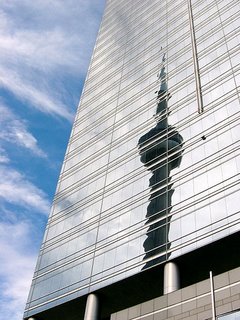
The roofs of the houses form terraces leading like steps to the citycore. The bank towers climb, and over them all the CN Tower soars, a landmark where no one lives or stays. ... This tower is a source of ghostly voices, turbulent speech, stray notes, and static, an infinite variety that may bear no single message, only the enticements and variations of energy, complex and nomadic, a stir and sound more enigmatic than any structure that we could make. (B.W. Powe, Outage. Toronto: Random House, 1995: 180-181)In the old story of Babylon, a great tower was built so the people could communicate directly with the gods. Angry at this arrogance, the gods caused the people to speak in different tongues, ending their collaboration and scattering the tribes across the land. Unable or unwilling to work through their differences, the people did not realize the tremendous gift they had received. The great tower fell into ruins.
The CN Tower is Toronto’s Tower of Babel. Originally built as a telecommunications tower and symbol of technological, architectural, and economic dominance, it rises above the city and both divides and connects us. Although we turn our backs on it, the CN Tower remains a sly presence in our photographs, memories, and narratives. It is always there, in the corner of our gaze. It is far from mute, and as a symbol it is far from stale. Indeed, Toronto writers continually appropriate the CN Tower in order to reinvent it as the site of resistance, memory, longing, and possibility.
In M.G. Vassanji’s No New Land (McClelland & Stewart, 1991), the CN Tower serves as a blinking beacon to Nurdin Lalani, a man who addresses silent questions to it from his living room window high above the Don Valley, and when asked by an even newer immigrant, “Where is your god?” points to the CN Tower, as remote and solid an image as their own homeland.
In Nalo Hopkinson's Brown Girl in the Ring (Warner/Aspect, 1998), the CN Tower is the beacon connecting two worlds: its energy suffuses the apocalyptic city and brings the possibility of new life. She writes, "like the spirit tree the centre pole symbolized, the CN Tower dug roots deep into the ground where the dead lived and pushed high into the heavens where the oldest ancestors lived. The tower was their ladder into this world."
In Darren O'Donnell's novel Your Secrets Sleep With Me (Coach House Books, 2004), the CN Tower is too derelict an image to redeem or be redeemed, and, as a central motif in the novel, it collapses into the Lake as it must, a lesson against hubris in a city whose occupants must all become refugees in order to start again.
Finally, in Dionne Brand's What We All Long For (Knopf, 2005), the CN Tower is symbolized and re-energized as a lubaio, a Chinese signpost, to which an artist pins the city's longings and wishes like prayers.
As Toronto's Tower of Babel, the CN Tower is a symbol of the great gift the gods have given us -- the gift of different tongues -- of the great challenge and opportunity to learn to communicate across language, culture, and experience in this younger Babylon.
(Image by Darcy Brown; used with permission)
This post was originally published at Reading Toronto.
No comments:
Post a Comment